1. Evidence and Counter Evidence
2. Evidence Proceedings
3. Verdicts
1. Evidence and Counter Evidence
The right to evidence proceedings was usually linked to a conditional final judgment, which, if the evidence proceedings were either not commenced or abandoned, became the final verdict. However, if a preliminary order allowing the plaintiff to live separated from bed and board existed at the beginning of the evidence proceedings, there was no judgment which came into force when the proceedings were not commenced or abandoned. In such cases, at the request of one of the married parties, the summary proceedings had to be concluded with a judgment.
As stated under Norms, the conditional final judgment or provisional order gave the applicant the opportunity to prove or refute certain allegations in a subsequent procedural step. The defendant spouse received the right to counter. In rare cases, the consistorial councils also granted the defendant spouse the right to evidence proceedings, provided that they had put forward good but insufficiently proven reasons for why he or she refused marital cohabitation.
Case Study: Franz Lackowizer | Barbara Lackowizerin, 1777
On 30 June 1777, the Vienna Consistory negotiated the second divorce action of Franz Lackowizer. The husband based his divorce claim on adultery. His wife gave birth to a child a few weeks before, whose father he could not be because “he had not had intercourse with her for more than 1½ years.” Barbara Lackowizerin countered the argument brought forth by the husband that he could not be the biological father with the reply that she had “slept with him once” within that period of time. However, Barbara Lackowizerin added that she could not deny that at that time she “also had dealings with another [man].”
The reason for her adultery, however, had been her husband because “he did not sleep with her and even went out with others and violated marital faithfulness”. The notary noted Barbara Lackowizerin’s legal interest as being “satisfied with divorce”, meaning that she was in agreement with a divorce. Although both spouses wanted the divorce from bed and board, and the wife had admitted to having committed adultery, the consistorial councils decided on a conditional final verdict, which gave the defendant wife the possibility of carrying out evidence proceedings:
that the plaintiff was to be divorced from bed and board from the defendant, if the defendant could not prove, as befitted rightly, that the plaintiff had given her reason for committing the known offense, or that he had also been guilty of the same crime of violating conjugal faithfulness.
Table 1: Conditional Final Verdict | Plaintiff Spouse
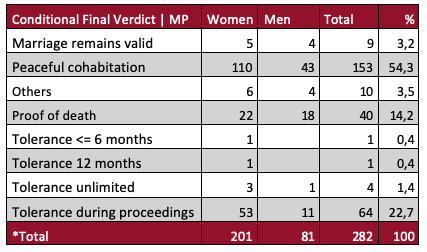
As Table 1 shows, the majority of conditional final judgments (54,3 %) dictated cohabitation. For example, in the separation proceedings initiated by Anna Denkhin on 1 July 1667:
The plaintiff is to live with her husband, as is to be expected in the holy state of matrimony, in the way this state deserves to be honoured and lived out. If she believes to have a considerable and lawful justification against marital cohabitation, she is obliged to submit these reasons to the court, and to prove them lawfully, however the defendant also has the right to provide counter evidence and to all other legal remedies.
As Table 1 also shows, 22,7 of the conditional final judgments granted the plaintiff spouse, the majority of whom were women, the right to live separated from the husband (or wife) for up to one year. Four of the conditional final judgments, including that cited in the divorce suit of Franz Lackowizer, divorced the marriage from bed and board.
Table 2: Conditional Final Verdict | Examined Time Periods
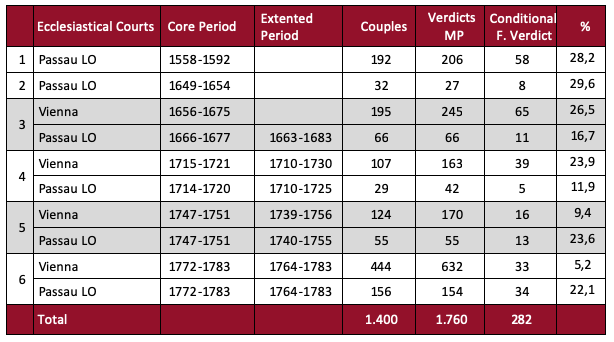
Table 2 makes it clear that in a total of 282 (16 %) of the 1,760 main proceedings investigated the consistorial councils did not make their decision in summary proceedings, but instead required the married parties to prove or refute certain accusations in a further procedural step. As Table 2 also shows, the proportion of conditional final judgments or instructions varied between 5.2and 29.6 percent.
It is striking to note that in the examined time segments in the middle of the 17th century and in the early 18th century the Vienna consistorial councils allowed for evidence proceedings in about a quarter of the matrimonial proceedings, while in the mid and late 18th century between 91,6 and 94.8 percent of the proceedings in the main were decided upon already in the summary proceedings.
The decisions of the consistorial councils of the Passau consistory of the Lower Officialat show a reverse trend. While in the mid-17th century and the beginning of the 18th century they ruled upon between 83.3 and 94,8 percent of the main proceedings already in summary proceedings, in the mid and late 18th century almost a quarter of the marital parties were referred to evidence proceedings.
It is noteworthy that the gender of the plaintiff spouse played no statistically significant role in the decision of the consistorial councils for or against the initiation of evidence proceedings. In 201 (15,8 %) of all main proceedings initiated by women and 51 (10.5 %) of those 484 initiated by men the church courts allowed evidence proceedings to be carried out.
2. Evidence Proceedings
Table 3: Conditional Final Verdict | Beginning of Evidence Proceedings
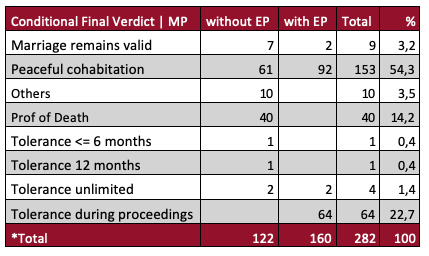
As can be seen from Table 3, 43,3 percent (122 of 282) of the conditional final verdicts came into force because no spouse had submitted a petition for evidence proceedings within the time period given. The proportion increases considerably if we do not count proceedings from the 16th century in which the consistorial councils demanded proof of death. As Table 3 also makes clear, the majority of married couples accepted the usually tedious and costly evidence proceedings in order to obtain annulment, divorce, or even a separation of bed and board instead of the conditional final verdict that required them to live together.
In two cases, the evidence was used to avoid a divorce or an unlimited tolerance, once by the wife and once by the husband.
Although Barbara Lackowizerin, according to the quoted protocol entry from 30 June 1777, agreed to the divorce, she made use of her right to evidence proceedings and requested cohabitation. Only five months later, on 5 December 1777, the consistory decided that she had failed to prove that her husband had given her due reason for committing adultery and that he himself had also been unfaithful, and declared the conditional final verdict to be final:
therefore, the accuser (of the summary proceeding) is hereby divorced from bed and board from the defendant, and he [the husband] is not required to live with her, but is allowed to live apart and alone, however respectably and faithful, and without being allowed to marry another person.
In the second case, it was the husband who, in evidence proceedings, sought to avert the divorce or unlimited tolerance which had been granted to the wife in the conditional final verdict.
Case Study: Anna Maria Engsbergerin, widowed Lindnerin | Franz Engsberger, 1775
Anna Maria Engsbergerin, widowed Lindtnerin, sued for divorce from her husband at the beginning of January 1775 because of severe physical abuse, which she was also able to prove with medical certificates. The couple had married in February 1765 therefore they had been married for almost 10 years at this time. In the conditional verdict from 29 March 1775 the Passau consistorial councils decided to grant the wife a divorce, provided the husband couldn’t prove that he had inflicted his wife’s severe abuse before his punishment by the secular court and before their reconciliation.
Franz Engsberger apparently did not succeed in providing the required evidence in a more than three-year trial. At the hearing on 29 May 1778, he agreed to withdraw from his right to evidence proceedings on the condition that Anna Maria Engsbergerin left him half of their assets, a condition which she refused to agree to. About three months later, at the hearing on 9 September 1778, Franz Engsberger renounced his right to evidence proceedings, however this time without any conditions, and agreed to the divorce. The Consistory declared the conditional final verdict of 29 March 1775 to be the final verdict, with which Anna Maria Engsbergerin was divorced from bed and board after a four-year trial.
Judging from arguments heard from both parties let the official and the consistory declare: that due to the declaration of the husband, submitted on 1 July 1778 and confirmed by the consistory on 9.9.1778, in which he completely renounces the right to provide evidence granted to him on 29 March 1775, the plaintiff (=wife) is allowed to live separately.
Table 4: Legal Interest in Evidence Proceedings | Gender
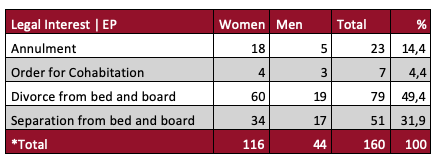
As Table 4 makes clear, gender also was no statistically relevant category for the question of whether or not the evidence proceedings (evidence and counterevidence) were commenced. While 57.7 percent of women (116 out of 201 potential cases, cf. Table 1: Conditional final verdicts) initiated the tedious and cost-intensive proceedings, the proportion of men doing so is 54.3 percent (44 out of 81 potential cases, cf. Table 1).
3. Verdicts
Table 5: Verdicts following evidence proceedings | Spouse submitting evidence

As Table 5 shows, we were unable to obtain verdicts from 42.5 percent of the 160 evidence proceedings. It is not always the case that the reason for this was that the “Abschied”, as the verdict was often called after the evidence proceedings, was not recorded in the minutes of the consistory. The verdict is also missing if the couple made an out-of-court settlement or if one of the spouses died during proceedings.
It is statistically striking that in half of the evidence proceedings carried out by women (56 out of 116) no verdict has been handed down, while in the case of evidence proceedings carried out by males, only slightly more than a quarter (27.3 %) of proceedings (12 out of 44) verdicts are missing. This suggests that women, perhaps for financial reasons, were more likely to reach an out-of-court settlement. Table 5 also shows that even after lengthy and costly evidence proceedings, spouses rarely succeeded in obtaining a temporary or unlimited tolerance.
Table 6: Verdict in EP | Legal Interest
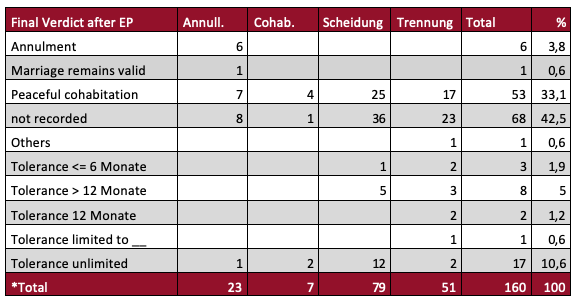
Table 6 differentiates the verdicts according to the legal interest of the spouse carrying out the evidence proceedings. If we additionally differentiate between women and men (Tables 6a and 6b), it becomes clear that gender played a role in the outcome of the evidence proceedings.
Table 6a: Verdict in Evidence Proceedings | Legal Interest | Women

Table 6b: Verdict in Evidence Proceedings | Legal Interest | Men
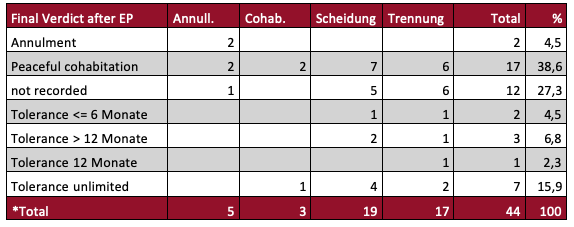
While in 18 evidence proceedings carried out by women for the annulment of a marriage the consistorial councils annulled only 4 marriages (22,2 %) and divorced one marriage from bed and board (see Table 6a), the proceedings with the same legal interests carried out by men resulted in the annulment of 2 from 5 (40 %) marriages (see Table 6b). However, this difference should be interpreted with reservations, since the final verdict is missing in seven annulment proceedings initiated by women (see Table 6a).
That the husbands more often succeeded in enforcing their interests in the evidence proceedings also becomes evident in the separation and divorce proceedings. As shown in Tables 4 and 6b, 36 husbands attempted to achieve a divorce in evidence proceedings. In six cases, the consistorial councils decided on an unlimited tolerance and in six proceedings on a limited tolerance (33.3 %).
By contrast, in the 94 evidence proceedings for a separation or a divorce of the marriage (see Table 4), the consistorial councils granted an unlimited tolerance only in eight cases and a limited tolerance in another 8 (17.4 ) cases (cf. Table 6a).
In four evidence proceedings the legal interest of the wives was cohabitation (see Table 4). In two of the cases, the consistorial councils decided in accordance with the application (see Table 6a), and in one case the verdict has not been handed down. In the fourth trial, the conditional final verdict, which granted the husband an unlimited tolerance, came into force, as Barbara Lackowizerin, as stated above, had failed to provide the required evidence.
Two out of three evidence proceedings carried out by the husbands to enforce cohabitation were successful (see Tables 4 and 6b). In the third case, the conditional final verdict, which granted the wife an unlimited tolerance, came into effect because Franz Engsberger, as stated above, had renounced his right to the continuation of the evidence proceedings after three and a half years of litigation.
Despite the high number of unknown verdicts, one can cautiously formulate the thesis that the husbands had a better chance of success than the wives in evidence proceedings.
Table 7: Final verdicts in the main proceedings | in the evidence proceedings
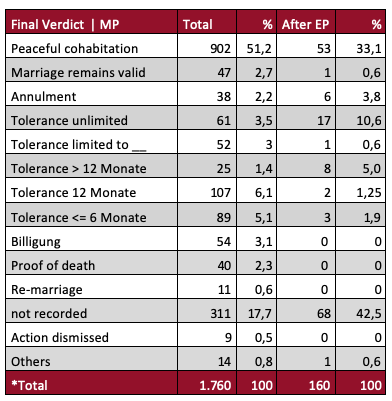
Finally, Table 7 once more makes it clear how difficult it was to achieve a divorce from bed and board or an annulment of the marriage from the consistory. While the first column does not differentiate, whether the verdict had already been made in the summary proceedings or only in the evidence proceedings, the second column lists the verdicts issued after evidence proceedings. Column 2 illustrates that from a total of 38 marriages 6 (15.8%) were annulled as a result of evidence proceedings. 17 (27.8 %) out of 61 divorces had been enforced only in evidence proceedings. The granting of a long-term tolerance was also preceded by evidence proceedings in around a third of the cases
Andrea Griesebner, June 2018, translation Jennifer Blaak
Last update, Andrea Griesebner, January 2020